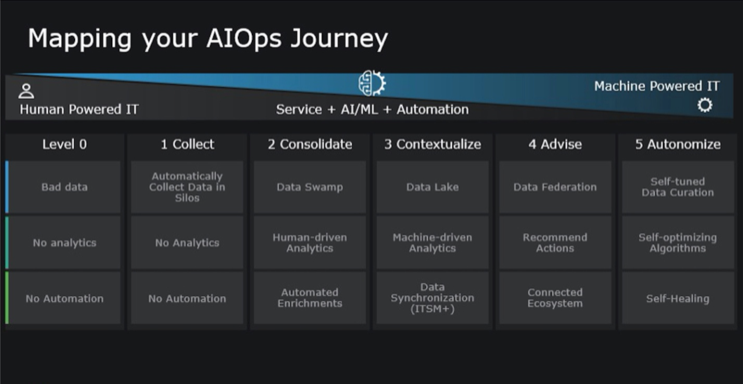The average meantime to repair (MTTR) for most organizations is 224 minutes. That’s nearly four hours of frustration for your users and customers who expect to be able to access the services and applications they rely on—and pay for.
Compounding the problem is IT operations teams getting bogged down in manual triage and diagnostics processes—keeping them from the tasks they were trained for as they sift through a haystack of big data searching for the needles they need to fix whatever problems they have to tackle. It doesn’t have to be that way. The average MTTR for top performing organizations is 38 minutes. That’s more than three hours faster or, looked at another way, three hours of cost savings and competitive advantage per incident.
How do you transform ITOM from average to top performer?
The key is moving on from legacy IT monitoring and adopting artificial intelligence for IT operations, otherwise known as AIOps. AIOps is engineered to operate in the fast-moving IT environments common in today’s software-defined enterprises.
Where legacy systems can’t see into many corners of today’s enterprise or keep up with the pace of change as applications and computing instances blink in and out of service, AIOps is designed to do just that. As a result, the data that is collected from all of your configuration items, including ephemeral services, is recognized in real-time and with the proper context to completely and accurately populate your configuration management database (CMDB). That gives your ITOM team the ability to eliminate most manual processes associated with incident triage and get right to the business of fixing things when they go wrong.
An AIOps platform, like ScienceLogic’s SL1, enables these efficiencies by supporting IT process automation that:
- Recognizes performance and fault issues when they happen;
- Generates associated events;
- Enriches service tickets with relevant diagnostics; and,
- Applies machine learning to recommend actions and/or initiate automated remediations.
It’s important to recognize that achieving the ideal of an ITOM model powered by AIOps is not a matter of flipping a switch. AIOps is a journey, but when approached strategically, it is a journey that delivers tremendous benefits from day one and builds from there. That’s because SL1 is designed with an out of the box automation library that delivers a broad set of processes and fixes for technologies that are common in most modern IT environments. These include things like Windows and Linux operating systems, virtualization components like VMWare and Microsoft Hyper-V, as well as support for products from the likes of Cisco, Citrix, F5, Juniper and more. From there SL1 has a wide range of PowerPack add-ons that are engineered for specific technologies and applications, whether you’re an MSP providing services to a roster of clients in a particular industry, or a large enterprise running your own data center.

From there the ITOM team can enhance their library with custom automated actions and processes that address issues unique to the organization. It’s an iterative process that starts by tackling smaller, easy to solve problems that deliver fast results and value, then builds momentum by cultivating champions who benefit from the efficiencies they now enjoy. Once begun, the journey AIOps then follows a maturity model that is a cycle of:
Collect > Consolidate > Contextualize > Advise > Automate. (Lather. Rinse. Repeat.)
Eventually, this process leads you to an ITOM model that achieves maximal efficiency through IT process automation that goes beyond simply eliminating much of the legwork that has your team tied up right now. Those early wins build a foundation on which you can support automated maintenance, including preventative maintenance that anticipates issues and takes corrective measures to avert problems that might otherwise be missed.
If you find yourself wasting time and resources looking for needles in your IT haystack, and would rather get straight to the point, check out this short webinar, “Reduce MTTR by Automating Troubleshooting,” presented by ScienceLogic principal solutions architect Ben Leyland. Ben will help you to better understand what AIOps is; how AIOps delivers complete, contextual visibility to IT operations monitoring; and how AIOps supports a host of IT process automation scenarios that can transform your IT organization from average to top performer. View webinar»
 See ScienceLogic in actionTake a Tour
See ScienceLogic in actionTake a Tour Take Skylar One for a SpinStart Your Test Drive
Take Skylar One for a SpinStart Your Test Drive The Gartner® Magic Quadrant™ for Observability PlatformsRead the Report
The Gartner® Magic Quadrant™ for Observability PlatformsRead the Report The Forrester Wave™: AIOps Platforms, Q2 2025Access the Report
The Forrester Wave™: AIOps Platforms, Q2 2025Access the Report Future-Ready IT: Secure Migration, Faster Value, and Smarter OperationsWatch Now
Future-Ready IT: Secure Migration, Faster Value, and Smarter OperationsWatch Now

